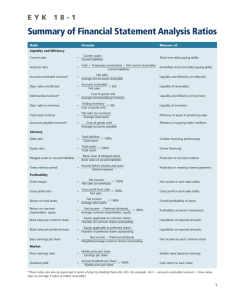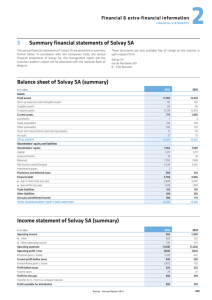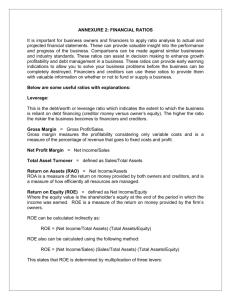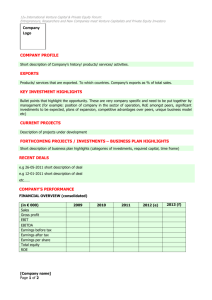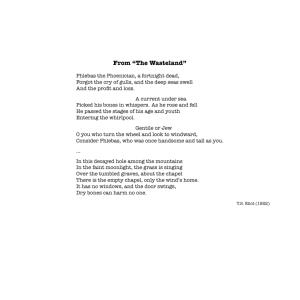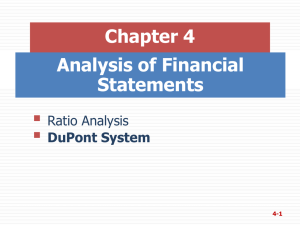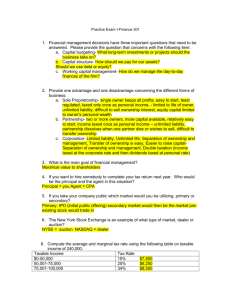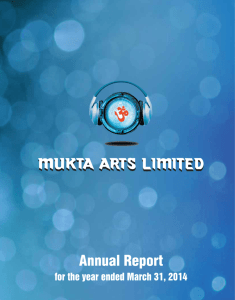Applying the Strategic Profit Model to the Real
advertisement
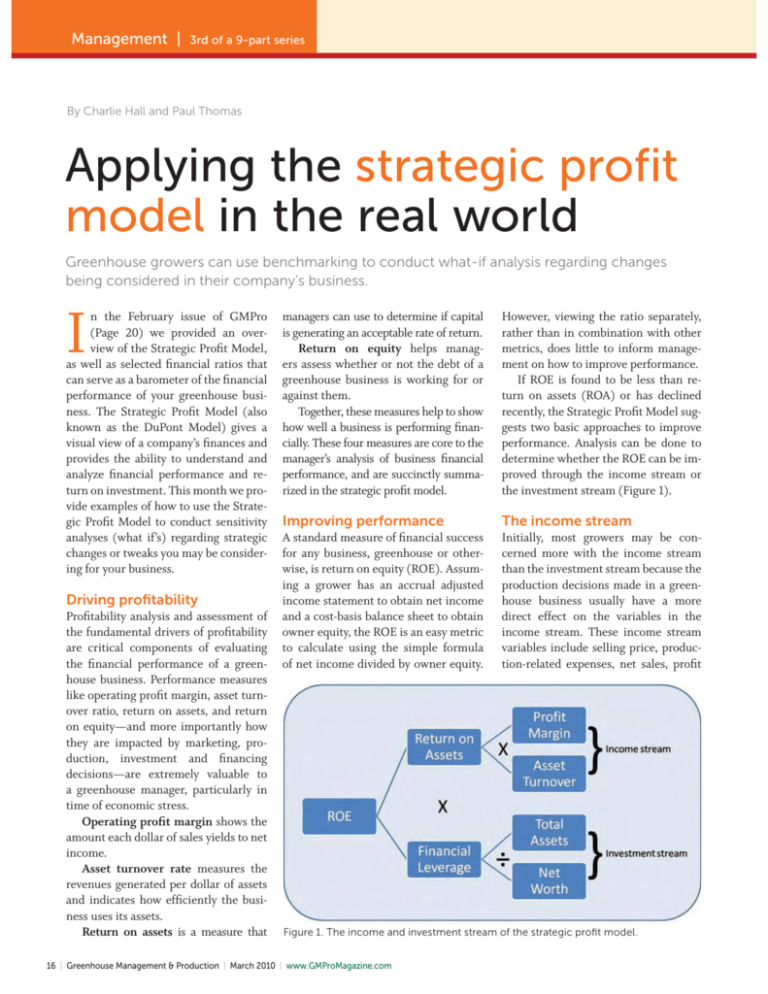
Management | 3rd of a 9-part series By Charlie Hall and Paul Thomas Applying the strategic profit model in the real world Greenhouse growers can use benchmarking to conduct what-if analysis regarding changes being considered in their company’s business. I n the February issue of GMPro (Page 20) we provided an overview of the Strategic Profit Model, as well as selected financial ratios that can serve as a barometer of the financial performance of your greenhouse business. The Strategic Profit Model (also known as the DuPont Model) gives a visual view of a company’s finances and provides the ability to understand and analyze financial performance and return on investment. This month we provide examples of how to use the Strategic Profit Model to conduct sensitivity analyses (what if’s) regarding strategic changes or tweaks you may be considering for your business. Driving profitability Profitability analysis and assessment of the fundamental drivers of profitability are critical components of evaluating the financial performance of a greenhouse business. Performance measures like operating profit margin, asset turnover ratio, return on assets, and return on equity—and more importantly how they are impacted by marketing, production, investment and financing decisions—are extremely valuable to a greenhouse manager, particularly in time of economic stress. Operating profit margin shows the amount each dollar of sales yields to net income. Asset turnover rate measures the revenues generated per dollar of assets and indicates how efficiently the business uses its assets. Return on assets is a measure that managers can use to determine if capital is generating an acceptable rate of return. Return on equity helps managers assess whether or not the debt of a greenhouse business is working for or against them. Together, these measures help to show how well a business is performing financially. These four measures are core to the manager’s analysis of business financial performance, and are succinctly summarized in the strategic profit model. However, viewing the ratio separately, rather than in combination with other metrics, does little to inform management on how to improve performance. If ROE is found to be less than return on assets (ROA) or has declined recently, the Strategic Profit Model suggests two basic approaches to improve performance. Analysis can be done to determine whether the ROE can be improved through the income stream or the investment stream (Figure 1). Improving performance The income stream A standard measure of financial success for any business, greenhouse or otherwise, is return on equity (ROE). Assuming a grower has an accrual adjusted income statement to obtain net income and a cost-basis balance sheet to obtain owner equity, the ROE is an easy metric to calculate using the simple formula of net income divided by owner equity. Initially, most growers may be concerned more with the income stream than the investment stream because the production decisions made in a greenhouse business usually have a more direct effect on the variables in the income stream. These income stream variables include selling price, production-related expenses, net sales, profit Figure 1. The income and investment stream of the strategic profit model. 16 | Greenhouse Management & Production | March 2010 | www.GMProMagazine.com Management margin and the use of assets. If growers discover a major weakness in their ROE, backtracking through the income stream and determining where changes can be made will easily identify a set of potential reasons for the weakness. For example, if a grower discovers his company’s ROA is unsatisfactory, this weakness can be traced back to asset turnover and net operating profit margin since these are the major components of ROA. The analysis can be further tracked to net sales and total costs if the operating profit margin is determined to be the main reason for the low ROA. Net sales could be improved by either increasing the price received (better marketing and differentiation strategies) or by increasing the volume of product sold (increasing yields or productivity; selling to larger buyers; finding new markets, etc.). Likewise, operating profit margin can also be enhanced by reducing costs of production (through the use of technology, automation, lean flow techniques, etc.). An astute grower will most likely consider all of these actions (Figure 2), but the Strategic Profit Model offers an opportunity to do some comparisons and determine what options will most benefit the producer. The investment stream The second approach to improving ROE, through the investment stream, culminates in the financial leverage multiplier (assets divided by equity/net worth). Increasing financial leverage means that a company uses more debt financing relative to equity financing. Interest payments to creditors are tax deductible, but dividend payments to any shareholders are not. Thus, a higher proportion of debt in a company’s capital structure can lead (mathematically) to a higher ROE. Financial leverage benefits diminish, however, as the risk of defaulting on interest payments increases. So if the greenhouse business takes on too much debt, the cost of debt rises as creditors demand a higher risk premium and ROE decreases. Increased debt makes a positive contribution to a company’s ROE only if the company’s return on assets (ROA) exceeds the interest rate on the debt. Most of the backtracking through the Figure 2. Strategies for improving operating profit and asset turnover in the greehouse business. Adapted from “Key Financial Performance Measures for Farm General Managers”, ID-243, Purdue University Extension. 18 | Greenhouse Management & Production | March 2010 | www.GMProMagazine.com Management investment stream follows total assets. From basic accounting, total assets are equal to total liabilities plus net worth (otherwise known as owner equity). This simply means all assets are either claimed by creditors or owners—allowing the investment stream to be broken into two additional sections, total debt and owner equity. It is important for a grower to understand what changes occur in ROE when liabilities, equity and assets are restructured. For example, a grower might hypothesize that by decreasing his business’ debt load, profitability will increase because the interest expense of the business decreases. However, by analyzing the investment stream of the Strategic Profit Model, the grower will realize that if this reduced debt load requires an increase in owner equity to maintain the asset base of the business, the financial leverage multiplier will decline and the ROE may also decline. Again, by performing simple comparative statistics, the grower will see the consequences of different financing decisions. A high ROE Is having a high ROE always better. As any economist worth his/her salt would say “It depends.” Generally, the higher the ROE the better since it represents the return to your own equity (sweat and otherwise). But not all high-ROE companies make good investments. Some industries have companies with high ROE because they require relatively few capital assets, such as some service-providing firms. Other industries require large investments in infrastructure before companies generate their first dollar of profit. However, you cannot conclude that service firms are better investments just because of their high ROE. Generally, capital-intensive businesses have high barriers to entry, which limit competition. On the other hand, high-ROE companies with small asset bases have lower barriers to entry, but they face more business risk because competitors can replicate their success without having to obtain much outside funding. Therefore, ROE is still a good indicator, but is best used when comparing companies in the same sector within an industry. In order to be profitable Profitability (or the lack thereof) has three parts: operating efficiency (profit margin), asset use efficiency (asset turnover) and financial leverage (equity multiplier). The successful greenhouse manager must be able to make effective decisions influencing all three elements. 1. To survive at all, a company must be effective in its use of revenues to gen- www.GMProMagazine.com | March 2010 | Greenhouse Management & Production | 19 Management erate profits (operating efficiency-profit margin). 2. To generate profitability, a company must use its investment in assets wisely to convert revenues to profit (asset turnover-efficiency). 3. If a company can generate a return on assets greater than its net borrowing costs, it can return profits to investors more effectively by financial leverage—using borrowed money to generate profits rather than tying up owners’ funds (equity multiplier). Needless to say, this must be analyzed very carefully. Charlie Hall is professor and Ellison Chair in International Floriculture, Texas A&M University, Department of Horticultural Sciences, charliehall@tamu.edu. Paul Thomas is professor and extension specialist, University of Georgia, Department of Horticulture, pathomas@uga.edu. An internet-based horticulture benchmarking system An internet-based financial benchmarking system (Horticulture Business Analysis System), was developed for the greenhouse and nursery industry through a partnership between the University of Florida and the Florida Nursery Growers and Landscape Association. The system, available at https://hortbusiness.ifas.ufl.edu/ analysis, is free of charge to all greenhouse and nursery growers. This system consists of data entry forms, a historical database of business records, a report generator and a security encrypted web site user interface. Users of the system can choose from a series of menus to create reports that summarize benchmark information in the database for selected nursery commodities or production systems, operation sizes, profitability levels, locations (state, county) and years. For more: Alan Hodges, University of Florida, Food and Resource Economics Department, (352) 392-1881, Ext. 312; awhodges@ufl.edu. 20 | Greenhouse Management & Production | March 2010 | www.GMProMagazine.com

